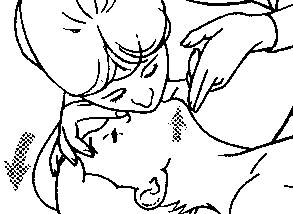For a Child Over One Year Old
Open the Airway
1. Place your child on his back on the floor, face up.
2. Look to see if there is any foreign material in your child's mouth. If you can see foreign material in your child's mouth, remove it with your finger, but do not sweep your finger blindly through your child's mouth.
3. Tip your child's head back by pushing on his forehead. With your other hand, gently lift the bony part of the jaw (see Figure 3.2, page 426). This positioning opens the airway.
4. Check for a pulse on the carotid artery, located at the side of the neck. Touch your first two fingers to the Adam's apple. Run your fingers across the neck to the depression between the Adam's apple and the large neck muscle. Press very gently so that you don't interfere with blood flow. Check for breathing by putting your cheek close to your child's mouth to feel for a breath, and watch his chest to see if it is rising and falling as in normal breathing. If your child is not breathing on his own, take steps to restore breathing (see step 5). If there is no pulse, initiate full CPR (go to step 9).
Restore Breathing
5. Once you have your child's airway open, pinch his nostrils closed, cover his mouth with yours, and give two slow puffs of air with enough force to cause your child's chest to rise and fall as in normal breathing (see Figure 3.5).
6. If your breaths do not cause your child's chest to rise and fall, repeat steps 1 through 3, above, to open the airway again. Give two more puffs of air.
7. If there is still no movement of the chest, the airway is probably blocked. Perform the Heimlich maneuver as follows: Straddle your child, squatting above his knees. Place the heel of your hand against his abdomen, just above the navel and below the rib cage. Place your other hand on top of the first. Use a quick, forceful upward push to force air up through the windpipe. If necessary, continue performing these thrusts until your child coughs up all of the foreign material. Do not stop the procedure until the foreign material is expelled and your child begins coughing, breathing, and talking on his own, or another person can take over for you, or medical help arrives.
8. If your child loses his pulse during this procedure, initiate full CPR (see step 9).
Full CPR
9. Place your child flat on the floor on his back. Check for a pulse on the carotid artery again. Only if your child's heart has stopped beating and you can't feel a pulse can you safely begin CPR. Never do chest compressions on a child with a heartbeat.

Figure 3.5 Rescue Breathing for a Child
Gently pinch your child's nostrils closed, cover his mouth with yours, and give two slow puffs of air.
10. If your child is not breathing and does not have a purse, straddle your child to give compressions. Locate the spot to give compressions by following the rib cage to where the ribs and sternum meet. Put your middle finger on this notch and your index finger right next to your middle finger. Notice the placement of your index finger and place the heel of your hand right next to it (see Figure 3.6). Keep your elbows straight and your shoulders dined up over your child's body. Maintain this position so that the compressions are done straight up and down on his chest. For each compression, push your child's breastbone 1/3 to 1/2 of total chest height (approximately 1-1 1/2 inches) straight down. Do not rock your body. Do not move into your child's chest diagonally. Release the pressure between compressions without taking your fingers off his chest.